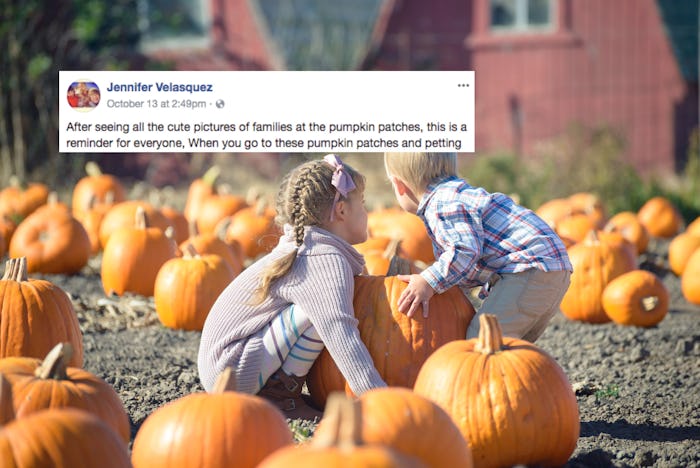Life
Why This Mom's Warning About The Hidden Health Risk Of Visiting A Pumpkin Patch Is Going Viral
It's finally fall, which means only one thing: it's pumpkin patch season. (OK, it also means pumpkin spice lattes and scarves and burgundy everything, but I digress.) Even though it's been a fairly warm fall, an annual visit to the pumpkin patch and the petting zoo is certainly in order. After one scary ordeal, though, one mom is warning other families to watch for ticks as they head out on their autumnal adventures.
Jennifer Velasquez, a mom from San Diego, California, recently posted a picture on Facebook of the intense rash she was left with after a tick bite gave her Rocky Mountain spotted fever two years ago. "After seeing all the cute pictures of families at the pumpkin patches, this is a reminder for everyone," she wrote on Facebook in a post that's now gone viral. "When you go to these pumpkin patches and petting zoos and all those fun fall activities, wear pants, long socks and shoes!"
Velasquez went on to explain that she had previously contracted Rocky Mountain spotted fever after visiting a pumpkin patch. The tick-borne infection — which leaves people with fevers, headaches, nausea, muscle pain, and a scary-looking rash — can be deadly if not treated quickly enough. And Velasquez didn't downplay the details in her post, writing:
I couldn't walk, my whole body was in pain, my hair fell out, and I almost died. I'm still healing from this. Don't be dumb and wear flip flops like me. CHECK FOR TICKS!"
It's been an unseasonably warm October in large parts of the United States and Canada, which means flip-flops can be appealing on trips to the countryside. But, unlike some other pesky bugs, ticks don't disappear once summer wraps up. A few species of ticks stop feeding in the fall, but many are still out and active.
"Temperatures have to drop below 10 degrees Fahrenheit for a long time in order for ticks to start dying off," Michael Dryden, a professor of veterinary parasitology at Kansas State University, told Prevention in 2013. And with the extended summer many parts of North America seem to be experiencing this year, that definitely hasn't happened.
To be clear, Velasquez isn't warning families to skip autumnal activities altogether. "I'm not saying don't go to a pumpkin patch," she wrote on Facebook, continuing:
Just be sure to cover up when you go, use repellent, and do a tick check when you get home. ... Better to be safe than sorry. Tick borne illnesses have exploded recently in southern California despite being told we don't have ticks out here.
Fortunately, if you live in an area where humans coexist with ticks, there are a few things you can do to lower your and your family's risk of contracting tick-borne diseases this fall. First of all, make sure everyone is wearing long pants, long-sleeved shirts, and closed-toe shoes, since that limits the amount of skin a tick can latch onto. According to Today's Parent, light-colored clothing will also also make it easier to spot ticks when you do a tick check on your kids later.
Once everyone is suited up, spray them down with a DEET- or icaridin-containing repellent, and make sure to conduct tick checks after everyone is back from the pumpkin patch (or the petting zoo or the walk in the woods). After tick checks, have kids jump in the shower to reduce their risk even further and toss dirty clothes into the dryer, using a hot cycle to kill any errant ticks hiding in pockets or folds.
If anyone develops a fever, rash, headache, or muscle and joint pain after a wander in the fall foliage, it's time to head to your doctor. However, with a bit of anti-tick preparation before, hopefully the only thing you'll be bringing back from the pumpkin patch is, well, pumpkins. (And maybe some pie, because hey, why not?)
Watch Romper's new video series, Romper's Doula Diaries:
Check out the entire Romper's Doula Diaries series and other videos on Facebook and the Bustle app across Apple TV, Roku, and Amazon Fire TV.
